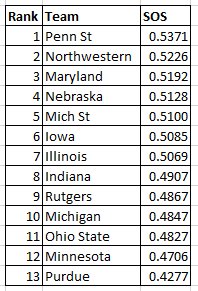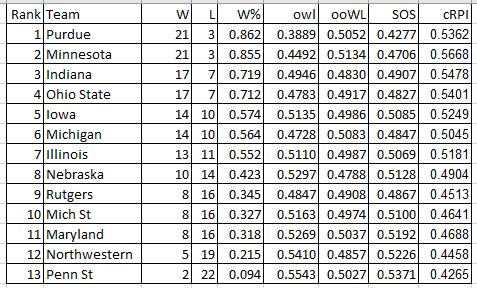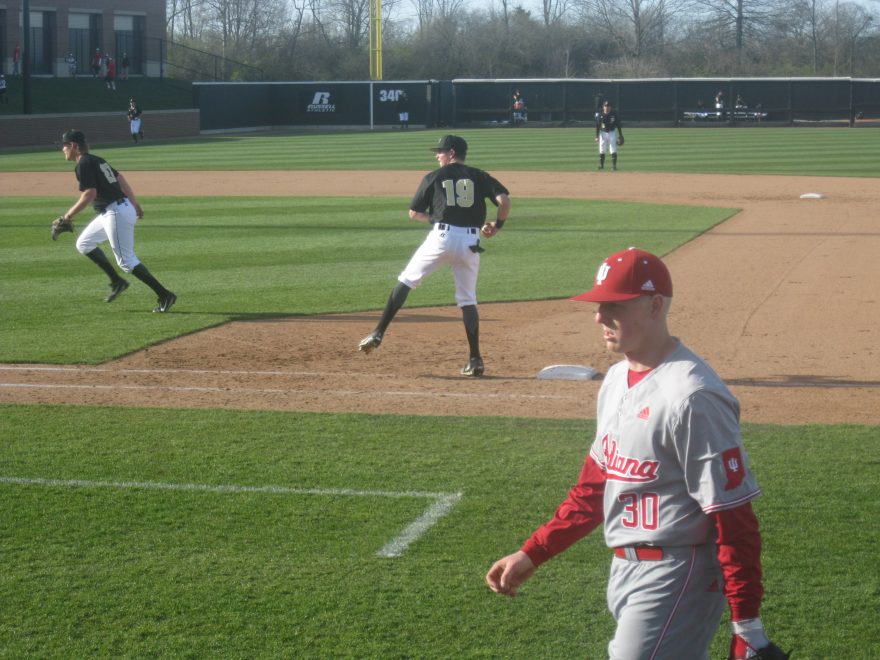by Carl James • @jovian34 • Dec 2
Early analysis on 2019 B1G schedule shows biggest advantage to the two teams that topped the conference last year.
The 2019 Big Ten (B1G) Baseball schedule is out. Chris Webb at Ten Innings has aggregated the schedule here. As in the past, the schedule is comprised of nine weeks, with each team playing eight of those weeks. At least one team must be off each week due to the fact that Wisconsin no longer has a baseball program making the B1G an odd numbered baseball league.
The other Power-5 leagues play 9 to 10 weeks to get up to 30 conference games in. Even so, the ACC and SEC both split into divisions while the B1G does not. The result is that the final conference standings are often horribly unbalanced.
The past two seasons I have produced a ranking that applies the NCAA’s RPI formula to B1G conference games to produce a strength-of-schedule adjusted final standing.
Here are the 2018 B1G cRPI Standings:

The best example is Michigan which finished in 3rd place in the conference, but was only in 7th place when adjusted for strength of schedule. Indiana, on the other hand, finished in 5th place when the Hoosiers would have been 2nd factoring in the strength of schedule.
Now that we have the full conference schedule for all teams for 2019, we can analyze the strength of schedule. I start by applying the 2018 win-loss record and 2018 opponent win-loss percentage of each team to the 2019 schedule. This generates an estimated strength of schedule based only on how teams performed in 2018. While there will clearly be changes in team strength from year-to-year, often these changes can wash when applied over 8 different teams. It is not perfect, but it is an objective, results-based preview that is a good place to start.
2019 B1G Strength-of-Schedule preview (ranked hardest to easiest):

Look at the bottom of this list and you see that last year’s top two finishers get the easiest schedule in 2019. The easiest by far goes to the Purdue Boilermakers.
The next thing I did was plug in the cRPI for each team against the strength of schedule to generate a predicted conference standing. Now this is entirely mathematical and the only data it includes is the 2019 schedule and the 2018 performance of each team. It assumes teams will perform the same year over year. So again, this is a good starting point, but not what I would call a final prediction. There is also a factor of the tail wagging the dog. A high cRPI usually requires a high SOS, so for a team like Purdue, the mix of a high cRPI and a low SOS will generate an unrealistically high win percentage prediction.

When I ran these numbers last year, Minnesota was the predicted champion. That came to pass but a lot of other things changed. My model failed to predict the strong finish of Michigan and Purdue.
The Hoosiers have a middle-of-the-road SOS, which is easier than over the past couple of seasons. This means that, unlike last season, it won’t necessarily take a domination of the league for Indiana to win a conference title. It may, however, take a little help. Purdue doesn’t have to play Indiana in conference, and even a 4th cRPI ranked Purdue team, with this schedule, will be positioned to win a conference title.

